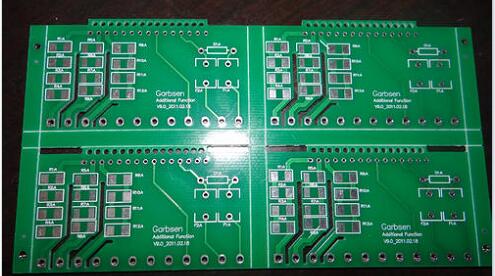1. Laminating
A new raw material is needed here called prepreg, which is the core board and the core board circuit board layer number>4), and the adhesive between the core board and the outer copper foil, which also plays a role in insulation.
The lower copper foil and the two layers of prepreg have been fixed in advance through the alignment hole and the lower iron plate, and then the finished core board is also placed in the alignment hole, and finally the two layers of prepreg, a layer of copper foil and A layer of pressure-bearing aluminum plate covers the core plate.
The circuit board clamped by the iron plate is placed on the support, and then sent to the vacuum heat press for laminating. The high temperature in the vacuum hot press can melt the epoxy resin in the prepreg and fix the core boards and copper foils together under pressure.
After the lamination is completed, remove the upper iron plate of the pressed circuit board. Then remove the pressure-bearing aluminum plate. The aluminum plate also has the responsibility of isolating different circuit boards and ensuring the smoothness of the outer copper foil of the circuit board. Both sides of the circuit board taken out at this time will be covered by a layer of smooth copper foil.
2. drilling
To connect 4 layers of non-contact copper foils in the circuit board, first drill through the upper and lower through holes to open the circuit board, and then metalize the hole walls to conduct electricity.
Use the X-ray drilling machine to locate the inner core board. The machine will automatically find and locate the hole on the core board, and then punch the positioning hole on the circuit board to ensure that the next drilling is from the center of the hole. Through.
Put a layer of aluminum plate on the punching machine machine tool, and then put the circuit board on it. In order to improve efficiency, according to the number of layers of the circuit board, 1 to 3 identical circuit boards are stacked together for perforation. Finally, a layer of aluminum plate is covered on the uppermost circuit board. The upper and lower aluminum plates are used to prevent the copper foil on the circuit board from tearing when the drill bit drills in and out.
In the previous lamination process, the melted epoxy resin was squeezed out of the circuit board, so it needs to be cut off. The profiling milling machine cuts the periphery of the circuit board according to the correct XY coordinates.
3. Copper chemical precipitation on the hole wall
Since almost all circuit board designs use perforations to connect different layers of circuits, a good connection requires a 25-micron copper film on the hole wall. The thickness of the copper film needs to be realized by electroplating, but the hole wall is composed of non-conductive epoxy resin and glass fiber board.
So the first step is to deposit a layer of conductive material on the hole wall, and form a 1 micron copper film on the entire circuit board surface, including the hole wall, by chemical deposition. The entire process such as chemical treatment and cleaning is controlled by the machine.
4. Outer circuit board layout transfer
Next, the layout of the outer layer will be transferred to the copper foil. The process is similar to the previous transfer principle of the inner core board circuit board layout. It uses photocopying film and photosensitive film to transfer the circuit board layout to the copper foil. The only thing is The difference is that positive films will be used for the board.
The layout transfer of the inner layer circuit board adopts the subtractive method, and the negative film is used as the board. The circuit board is covered by the cured photosensitive film as a circuit, and the uncured photosensitive film is cleaned. After the exposed copper foil is etched, the circuit board layout circuit is protected by the cured photosensitive film.
The transfer of the outer circuit board layout adopts the normal method, and the positive film is used as the board. The non-circuit area is covered by the cured photosensitive film on the circuit board. After cleaning the uncured photosensitive film, electroplating is performed. Where there is a film, it cannot be electroplated, and where there is no film, copper is plated first and then tin is plated. After the film is removed, alkaline etching is performed, and finally the tin is removed. The circuit pattern remains on the board because it is protected by tin.
Clamp the circuit board with a clamp, and plate the copper on it. As mentioned earlier, in order to ensure adequate conductivity of the hole, the copper film plated on the hole wall must have a thickness of 25 microns, so the entire system will be automatically controlled by the computer to ensure its accuracy.
5. Outer circuit board etching
Next, a complete automated assembly line completes the etching process. First, clean the cured photosensitive film on the circuit board. Then use a strong alkali to clean the unnecessary copper foil covered by it. Then use the tin stripping solution to strip the tin plating on the copper foil of the circuit board layout. After cleaning, the 4-layer circuit board layout is completed.
